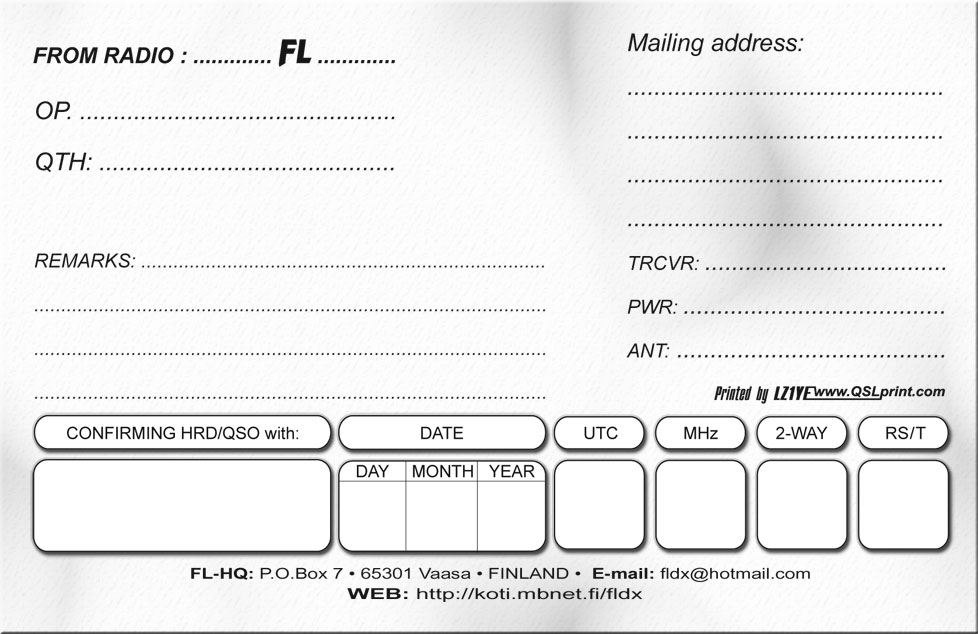Filling QSL Cards
There is a large number of 11m DX groups in the world that sell different QSL card models to their members, and if you need a bigger amount of QSL cards, it is nowadays cheap to print those cards in one of the many QSL card print shops that you can find on the Internet.
Here is a brief look into filling QSL cards.

QSL Card Fields
- Confirming QSO with
- Callsign of the station you had QSO with — for example 317XX001
- Op., Operator
- Operator name (the personal name) of the station
- Date
- Date according to UTC time – Sometimes this is different than the date in your local time.
- UTC
- UTC time — Time is filled in UTC on QSL cards. Notice that the date for the QSO on the QSL must be also the date according to UTC, which might be different than in your local time.
- MHz
- The Frequency the QSO took place on – In this case, we would fill in 27. Usually, QSL cards have space for filling the full frequency, for example 27.625. If the card has only a field for the band, write 11m to that field.
- 2-way, Mode
- 2-way, Mode — used mode FM or SSB
- RS(T)
- RS Report (T stands for tone and is only filled in CW QSOs.) Depending on the QSL card the RS report is filled in the form 59 or 5/9, in this case 59. If the QSO was via Aurora, you can add an A to the report (tone part) even if the QSO was a normal voice QSO, for example 46A.
- Remarks
- Remarks, comments — a place for your short comment
- PSE QSL/TNX QSL
- PSE QSL = Please QSL — TNX QSL = Thanks for the QSL
You should select the correct choice depending on whether you have already received a QSL from the station you are sending the card to or if you are waiting for a card in return.
Required Information
The card must have at least the callsign of the station you had the QSO with, date and time, channel or frequency, and an RS report.
The card might also have a field for filling in your own address. Some cards have even more fields for extra info. These extra fields could be: TRCVR, RXTX or RTX (your transceiver), Antenna/ANT (your antenna), Power/PWR (your transmit power used during the QSO), QTH (your location at the time of the QSO), WX (the weather).
The RS part of the RST system
R = Readability
- Unreadable
- Barely readable, occasional words distinguishable
- Readable with considerable difficulty
- Readable with practically no difficulty
- Perfectly readable
S = Signal strength
- Faint signals, barely perceptible
- Very weak signals
- Weak signals
- Fair signals
- Fairly good signals
- Good signals
- Moderately strong signals
- Strong signals
- Extremely strong signals
In Practice
Usually, on 11 meters, many stations give the R part of the report by listening and assessing the readability but look for the signal on the radio's signal meter. If you wish to give the report correctly, you will also give the S part of the report without looking at your signal meter. Every number on the S scale has a meaning as you can see in the list above.
Sending the QSL
When you send out QSL cards, it's good practice to put your own address on the back side of the envelope. In this case, if there's an error in the address and the letter cannot be delivered, the post office in that country usually returns the undelivered letter to the sender.
It's not recommended to add callsigns or DX group stamps/stickers to the envelope. Only the name and the address of the sender and recipient should be enough. Adding a callsign to the envelope can even cause problems for the recipient. Also when writing the address, it is better to avoid cursive writing and write the address in clear capital letters instead.
When sending card(s) to a QSL manager, always include the required contribution and a SAE (self-addressed envelope) or a sticker with your address.
In Case Your QSL Gets Returned

In case your QSL gets returned by the post office for some reason or another, you can find an explanation of the French and Spanish language endorsements that might be on the letter at: http://pe.usps.gov/text/imm/immc7_024.htm (see: 771.3 Endorsements)